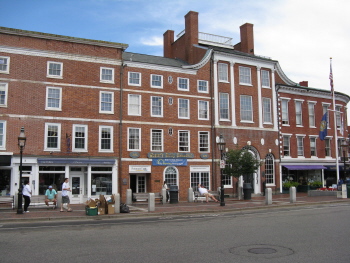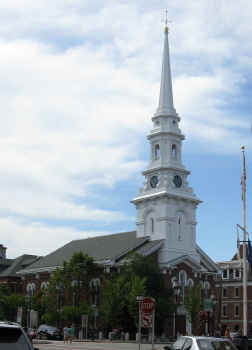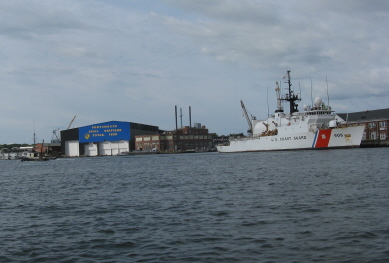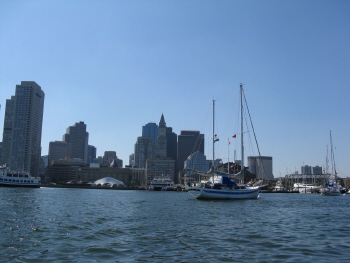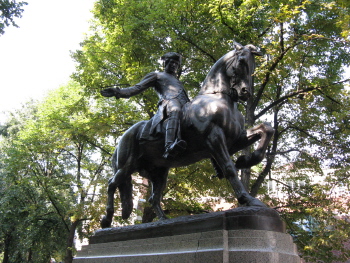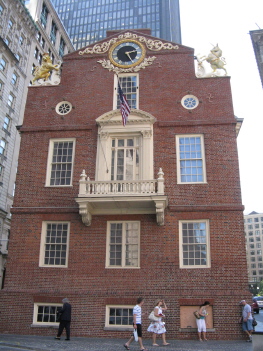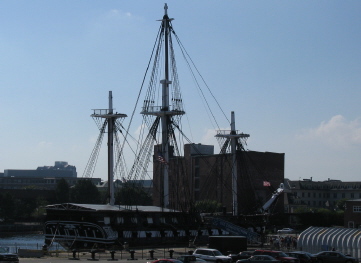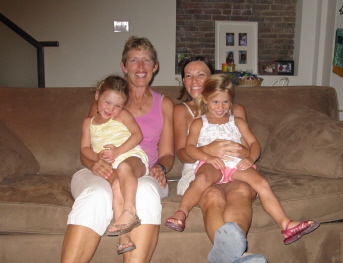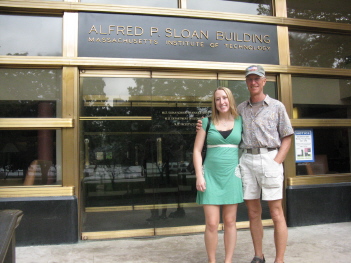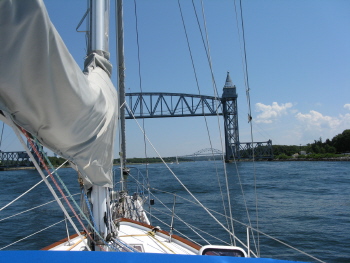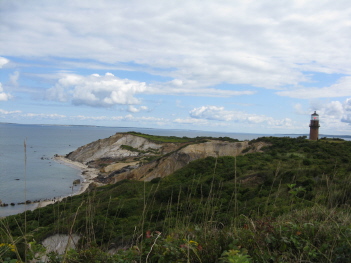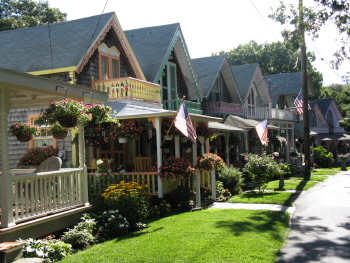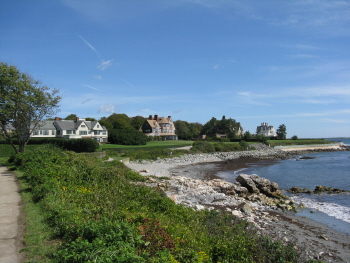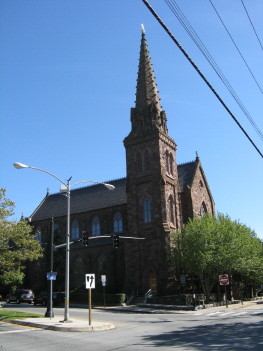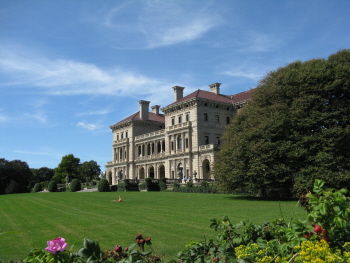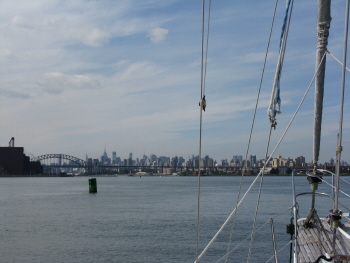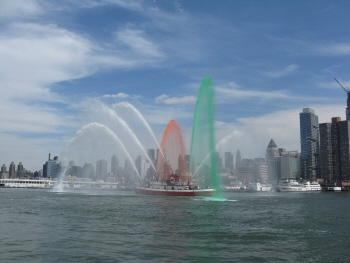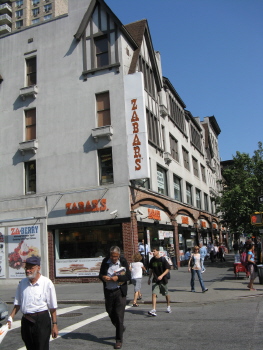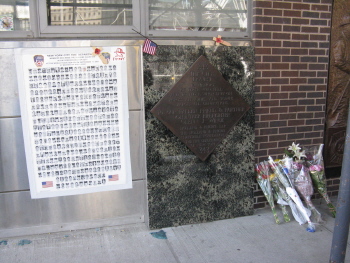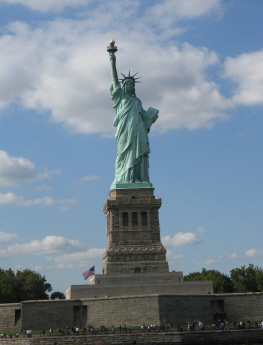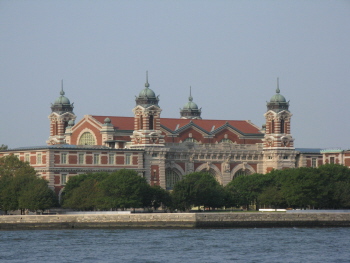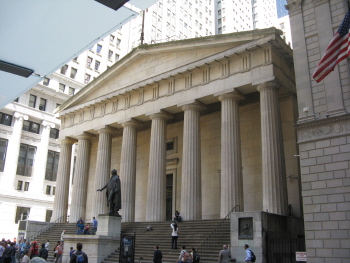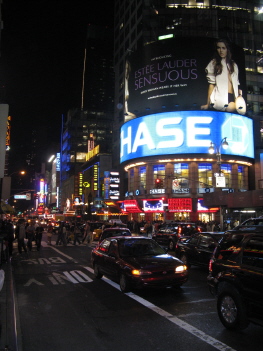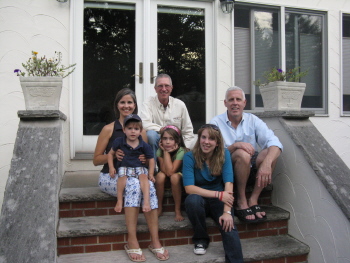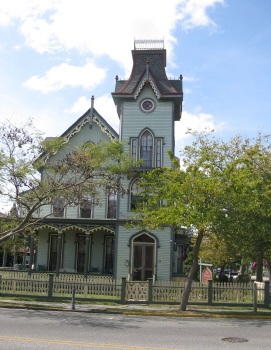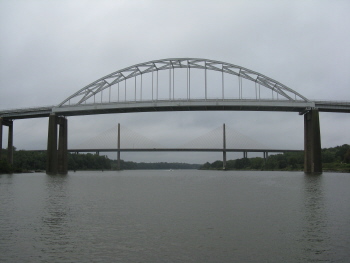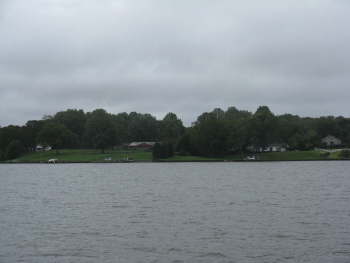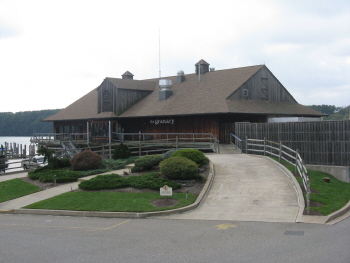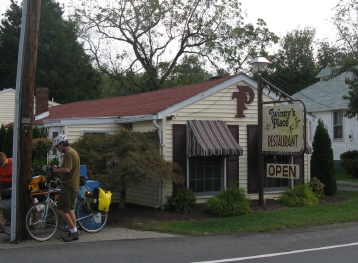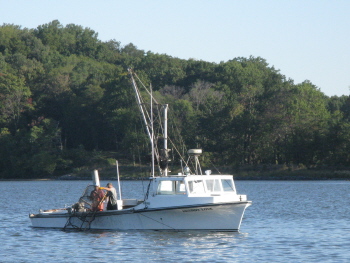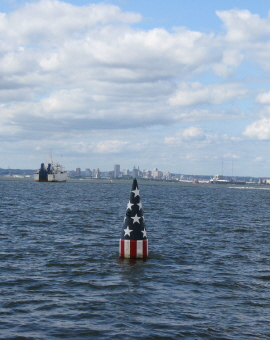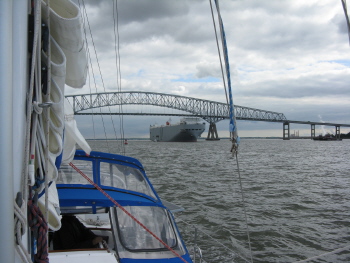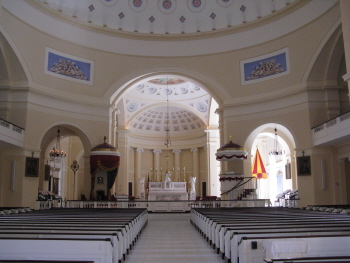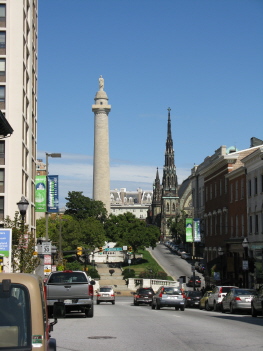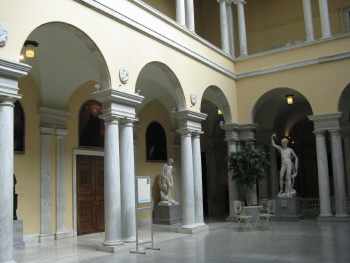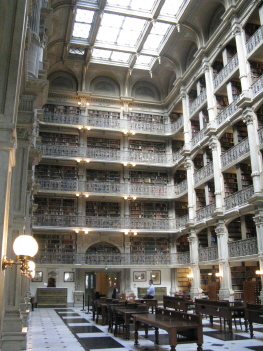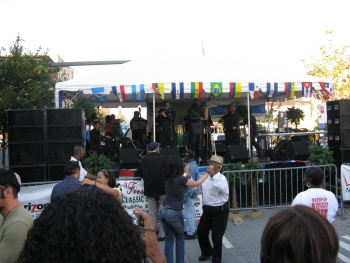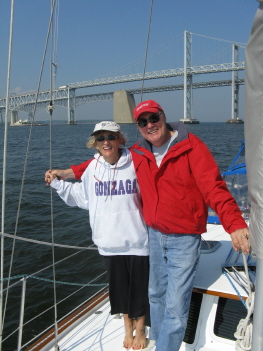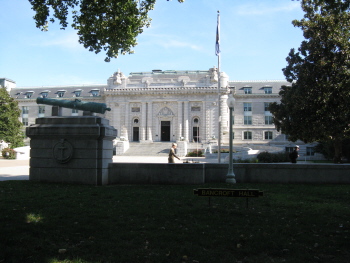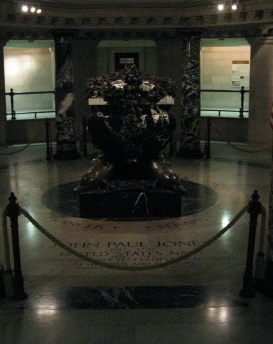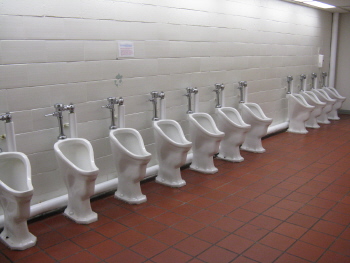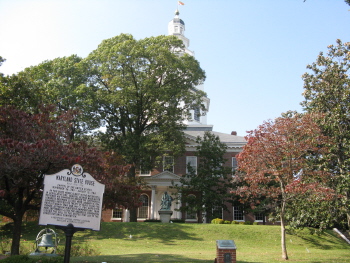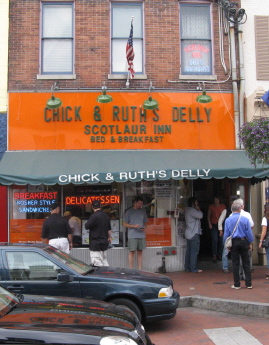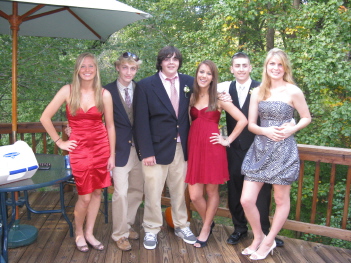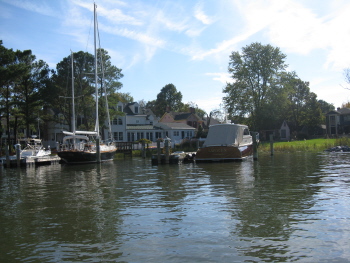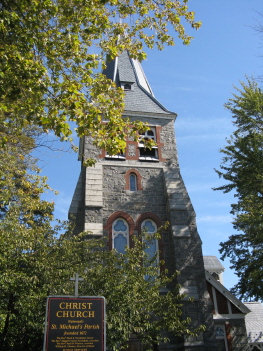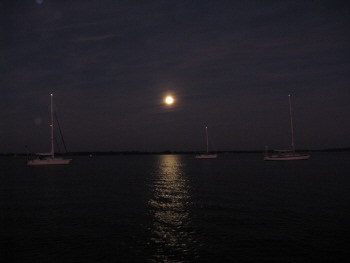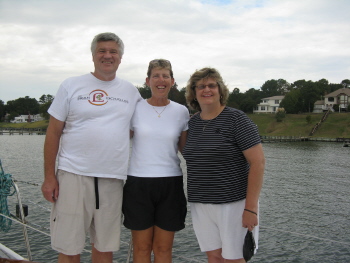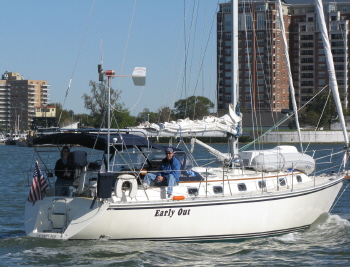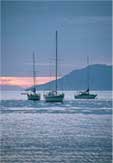
Current Location
(enter callsign KG6NNZ)
|
Logbook: Northeast U.S. & Chesapeake Bay - September to
October 2008
After spending August in Maine, we traveled south along the East Coast of the U.S., stopping along the way in the New England states of New Hampshire, Massachusetts, and Rhode Island, and then continuing on to New York City, New Jersey and the Chesapeake Bay. There is an incredible amount of history to absorb in this area, and it was great to see the historical sights and have an opportunity to relearn some of those history lessons taught to us so long ago in school. We also thoroughly enjoyed visiting a number of family members and friends who live on this coast. Passage from Great Chebeague Island to Portsmouth, New Hampshire (September 1 - 62 nm, 10½ hours). As mentioned on our previous web page, we had beautiful sailing winds but god-awful biting flies on this passage. We arrived at our destination late in the afternoon and initially intended to anchor for the night offshore at the Isle of Shoals and come into Portsmouth the next morning. We were able to find protection from the northwest winds by anchoring between Smuttynose and Cedar Islands. However, there was a slight southeast swell coming into this anchorage, so it was a little rolly, and it also felt a bit tight - the rocks were too close for comfort. So, we weighed anchor and headed into Portsmouth's Little Harbor, arriving and dropping our hook in this more comfortable anchorage just as the sun set.
|
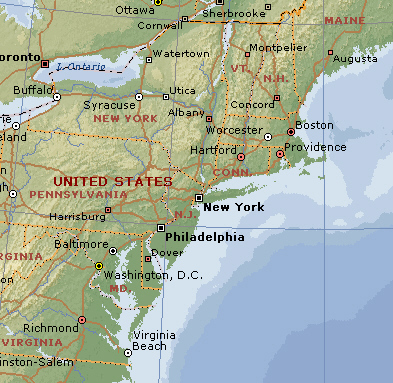 |
Portsmouth, New Hampshire (September 1-3). Portsmouth was settled in 1623 on the Piscataqua River and flourished as a regional seaport until the early 1800's. In the mid-1800's, the arrival of the railroad brought new industries - foundries, machine shops and textile mills. By the late 1800's, Portsmouth was one of the largest beer and ale brewing cities in the U.S. The Portsmouth Naval Shipyard was established by the Federal Government in 1800, and since World War I, it has specialized in submarine construction and repair. The history and architecture in this area has drawn tourists since the early 1900's. We spent a day in Portsmouth, following the Harbour Trail Walking Tour, which kept us occupied all day. It's a beautiful and charming town with lots to see - definitely a good place to stop and explore.
|
|
|
|
| Boston, Massachusetts
(September 3-8). From Portsmouth, we traveled to Boston and had good sailing winds in the middle part of the day
(56 nm, 10½ hours).
While underway to Boston, we heard several recorded VHF radio announcements from
the Coast Guard about whale sightings and proper protocol so as not to disturb
them. We had a good laugh when the announcement stated "Please be advised that
whales may not stay in the area where they were originally sighted."
Duh!!! As we were entering Boston harbor, we sighted some whales blowing their spouts - very cool! We spent our first night in Boston anchored out at Peddocks Island, in the Boston Harbor Islands National Park. The next morning, we motored into the city and picked up a mooring at Boston Waterboat Marina. We were in a great location just off Boston's Long Wharf. |
|
It had been years since either of us had been to Boston, and we were eager to do some sightseeing. Boston bills itself as "America's Walking City," and we spent many hours touring it on foot. Throughout the city, one can follow the Freedom Trail, which is a 2½ mile red brick walking trail that leads to 16 historical sites. The National Park Service offers free ranger-led walking tours along the Freedom Trail - your tax dollars at work. We arrived at the National Park Service's Visitor Center just in time to catch one of the tours, and we spent about 90 minutes visiting several of the historically significant American Revolution sites, such as the Old North Church and Paul Revere's Home. Over the next several days, we explored more of the Freedom Trail and toured the USS Constitution, the oldest commissioned warship afloat in the world.
|
|
|
|
In addition to sightseeing in Boston, we had several friends and a niece to visit here. Our cruising friends Jon & Heather (Evergreen), met us for dinner one night and introduced us to Mike's Pastry Shop, a favorite among locals. We also saw Julie (Hupman) Ocko, one of Jan's girlfriends who used to live in Los Angeles. We think the last time we saw Julie was at our wedding (in 1999). Julie got married a couple years after us, and she and her husband Rob have four-year-old twin daughters. We unfortunately didn't get to meet Rob, but we had a great evening with Julie and the girls, Michaela and Isabel. We also met our friend John Guthrie for Sunday morning brunch. Jan has known John for about 25 years. When they first became friends in Cincinnati, John was an aerospace engineering student. He gave up engineering many years ago and is now a successful artist (www.johnkguthrie.com). Last but not least, we visited with our niece Melissa, the daughter of Rich's brother Bob, who is in her second year at MIT's Sloan Business School. She gave us a personal tour of the MIT campus.
|
|
|
On the day we met Melissa at MIT, we had to cut our visit a little short due to weather. Hurricane Hanna was headed up the coast, and although downgraded to a tropical storm, it was expected to hit Boston that evening. We were expecting rain and winds ahead of the storm and wanted to be aboard Slip Away in case there were any problems. We had some rain that afternoon and evening, but fortunately, Hanna passed far enough offshore so as not to be a problem. The most wind we saw was about 25 knots. Rich stayed up reading for a good part of the night and watched the barometer drop as the storm passed by, but we were quite happy that it was pretty much a non-event.
| Passage to Onset, Massachusetts (September 8 - 58 nm, 11 hours). We left Boston early in the morning, motored out of the harbor and into Massachusetts Bay and then turned toward the Cape Cod Canal. Winds were light, and we needed to go slowly to time the tide right at the Canal, so we put up our spinnaker and drifted along. We sailed with the spinnaker for a couple of hours before the wind finally died altogether and we had to turn on the engine. It was great to have that sail flying again - it had been a long time! We arrived at the Cape Cod Canal at slack tide, so we didn't have quite the push as the last time we transited, but the current started to pick up about half way through. There are a couple of bridges over the canal - a fixed highway bridge and a railroad lift bridge, which is normally open, and there is plenty of clearance for us to pass under both of them. However, as we were approaching the railroad lift bridge, the Coast Guard was out on the water with a megaphone announcing that the bridge was closing, and we could not proceed. The current was gaining strength at this point, pushing us through the canal, so we needed to turn around and motor into it while waiting for the bridge to open. The operation was pretty efficient - the train passed over the bridge and in about a half hour, the bridge was lifted and we were on our way again. Shortly thereafter, we pulled into the anchorage at Onset. |
|
Onset, Massachusetts (September 8-10). Onset is a small town at the western end of the Cape Cod Canal. Rain and high winds were forecast for the next afternoon, and Onset has a well protected anchorage, so we stayed put for a day. We took advantage of the nice morning by going for a walk, picking up a few provisions and doing some laundry at the great laundromat in town. While in town, we ran into David and Leslie on Blue Yonder, whom we met in Boston, and we went out for lunch. As we were finishing up lunch, the skies opened up and poured rain. We waited for the worst of it to pass, and we had our laundry in plastic garbage bags and our rain ponchos with us, so we made it back to Slip Away relatively dry.
Martha's Vineyard, Massachusetts (September 10-12). From Onset, we had an easy trip to Martha's Vineyard (21 nm, 4 hours). Winds were light, so we motored across Buzzard's Bay, and timed our passage through Woods Hole on the slack tide. (Woods Hole has a reputation for some wicked currents, and by going through at slack tide, we could avoid them.) As we arrived at the anchorage at Vineyard Haven, the winds started to pick up from the north, and unfortunately the anchorage is open to that direction. We dropped our anchor and ate lunch, and during this hour, the seas became very choppy and extremely uncomfortable . So we weighed anchor and picked up a mooring ball behind the breakwall which offered protection from the seas. The winds and seas calmed down that evening, and southerly winds were forecast for the next day, so the next morning, we moved back out to the anchorage. (The mooring ball cost $40/night, but the anchorage was free.)
After moving Slip Away back to the anchorage, we started our tour of Martha's Vineyard. The previous afternoon, we had stopped by the Visitor Information Center and gotten some recommendations on how to spend our day. We bought an all-day pass for their public bus system ($6/person), and took the bus all over the island. First, we visited Gay Head Cliffs, which were gorgeous. We hiked around that area for a bit, then caught a bus to Edgartown, where we had lunch and spent some time doing a walking tour. From Edgartown, we took the bus to Oak Bluff, where we did some more walking, saw the pretty gingerbread houses, and then enjoyed a couple of beers at their Offshore Ale House. (Their beer was good and strong - we each had a buzz after one!) From Oak Bluff, we took the bus back to Vineyard Haven.
|
|
|
Martha's Vineyard was a beautiful and interesting island, and although we weren't able to see it all, we managed to get a pretty good overview in one day. Prior to coming here, a number of people told us that September would be a great month to visit the Cape Cod area because the crowds disappear after Labor Day. This was pretty much true; however, September appears to be the time when all the senior citizen bus trips come to Martha's Vineyard. That wouldn't be a big deal, except the one complaint we had about Martha's Vineyard is that public restrooms are few and far between. Even the restaurant where we ate lunch in Edgartown didn't have a restroom. Since the senior bus trips normally have a lot more women than men, Jan often found herself standing in long bathroom lines with the older gals. She enjoyed talking with these ladies, but she would have been happier if Martha's Vineyard had a few more public bathrooms.
Newport, Rhode Island (September 12-16). From Martha's Vineyard, we motored back through the Woods Hole passage and across Buzzard's Bay to Newport (44 nm, 8 hours). We didn't plan it this way, but we ended up in Newport on the weekend of their boat show. Our cruising friends Robin & Michael (Sea Biscuit) drove up to Newport from Connecticut to come to the boat show, and we spent a great day with them.
In addition to the boat show, we did some other touring of Newport. During the last half of the 1800's, Newport was a summer getaway for millionaires benefiting from the industrial revolution, and these rich families (folks like the Vanderbilts and Astors) built beautiful mansions in Newport. Most of the mansions have been maintained and/or restored, and we strolled past them along the famed Cliff Walk. We also poked our heads in at Newport's St. Mary's Church, which was built in the 1800's and where John F. Kennedy and Jacqueline Bouvier were married in 1953. It was probably the most beautiful church we've ever seen.
|
|
|
|
Passage to New York City (September 16-17 - 147 nm, 28 hours). We left Newport headed for Manhasset Bay, near the northwest corner of Long Island. For most of this passage, we had almost no wind, but the seas were glassy calm, and during the night, we had a beautiful full moon as we motored across Long Island Sound. We were able to shut down the engine for a couple of hours early in the morning when a bit of wind finally came up. We arrived in Manhasset Bay at 8:30 am, dropped our anchor and made some breakfast. We had initially planned to spend a night here, but the timing for the tides was perfect for us to continue into New York City. So, an hour later, we weighed anchor, and continued on. We passed through the infamous "Hells Gate" entrance into the East River at slack tide, so we avoided the strong currents that can run through there. We motored down the East River with the skyscrapers of Manhattan off our starboard side, rounded lower Manhattan, and turned up the Hudson River to the 79th Street Boat Basin on Manhattan's Upper Westside. The 79th Street boat basin had one available mooring - all the way at the front of the mooring field, so it was about a mile to the dinghy dock, but we were happy to have it. The tidal currents run pretty strong along the Hudson River, so we felt more comfortable on a mooring than at anchor, and where else can you stay in upper Manhattan for $30/night?
|
|
|
| New York City (September 17-22).
How exciting to be in the Big Apple! Rich lived in New York for a few
months in the late 1980's and Jan had visited the city several times in the
past, but it was pretty special to be here on Slip Away. This was
something we had talked about doing for years. Although it was a long ride
to the dinghy dock (and when the wind was blowing against the current, it was
a pretty rough ride), from there, it was a short walk to the subway at 79th and
Broadway. We were looking forward to several days of sightseeing and
visiting with a couple of family members - our niece Brittany (the daughter of
Rich's brother Ron and his wife Kim) who is a freshman at NYU and Rich's cousin Jane who lives in
New Jersey.
We had beautiful Fall weather during our time in New York, and we packed in as much as possible. We visited the World Trade Center Site and memorial museum, which was incredibly moving. (Jan was glad they had conveniently scattered boxes of tissues throughout the museum.) We also took a tour to the Statue of Liberty and Ellis Island, joined a Wall Street walking tour of the downtown historical area, visited Grand Central Station, saw "Hair Spray" on Broadway (great show! George Wendt - Norm from Cheers - played the part of Edna), stopped by Rockefeller Center and in general did a lot of walking - along Fifth Avenue (in the throngs of people), through Central Park (packed with people on a sunny Saturday afternoon) and along Broadway at night (reminded Jan of Sunset Boulevard in Los Angeles). We also enjoyed the food - New York Pizza for lunch most days and the chocolate croissants from Zabar's Bakery were incredible. (Zabar's was a short walk from the marina, and we went there EVERY day!) We spent a Sunday afternoon in New Jersey at the home of Rich's cousin Jane and her family - husband John and kids Carter and Jack. We hadn't seen each other in a long time - Jan had never met John, and it was the first opportunity for both of us to meet the kids. It was a great way to spend our last day in New York. |
|
|
|
|
|
|
|
|
|
Passage from New York City to Cape May, New Jersey (September 22-23 - 135 nm, 23½ hours). We dropped our mooring ball at the 79th Street Boat Basin early on a Monday morning; motored down the Hudson River past lower Manhattan, the Statue of Liberty and Staten Island; and rode the outgoing tide through the Narrows under the Verrazano Narrows Bridge. We motored until mid-afternoon, when the wind came up and we set our sails. The wind got pretty brisk that evening, and we were arriving at our destination too quickly (before sunrise), so we furled our genoa and sailed under main alone. Our wind anemometer had quit working during the summer, so we didn't really know how hard the wind was blowing, but we were guessing it was 20-25 knots.
During Jan's middle-of-the-night watch, she got a call from a tug captain on a fuel barge, who saw our running lights and let her know that he would stay clear of her. How nice! We usually don't get a call from someone unless we're in their way. Jan ended up speaking with the tug captain a number of times during the night, and she found out he, too, was a sailboater. (That explained why he was so nice!) His name was Bill, from Massachusetts, and he said he and his wife would be bringing his boat Spirit to South Carolina in the next month, so he would look for us when they were underway. A month later, totally by chance, we found ourselves waiting for the same bridge in Norfolk as we traveled along the ICW - small world!
| Cape May, New Jersey (September
23-26). We arrived Cape May early in the morning and tucked into the
anchorage. We'd heard good things about this town and were looking forward
to visiting it.
Cape May has been a tourist destination since the 1700's; in 1761 it officially became the first seashore resort in America. Cape May has hundreds of restored Victorian mansions and is one of five cities in the United States that is designated as an Historic Landmark City. Walking into town, we passed by many beautiful Victorian homes and we saw lots more on their trolley tour. At the recommendation of our friend Mike, who is a commercial fisherman, we had a great and reasonably priced seafood lunch at the Lobster House coffee shop. We also bought more fresh seafood to cook on Slip Away at the Lobster House's Fish Market. We didn't loiter while touring Cape May because it was a windy day (blowing about 20 knots), and we wanted to get back to Slip Away to make sure everything was OK. Winds were expected to build that evening to about 40 knots the next day, so we were staying put and expecting to spend the next day on board. The anchorage at Cape May wasn't perfect, but we felt it offered sufficient protection. There were six boats in the anchorage, and one of them, a power boat, anchored a bit too close to us for comfort, so we were keeping an eye on him. By early afternoon the next day, the winds were blowing about 25-30 knots, and the power boat's anchor started dragging. Jan looked out the window and saw them dragging past us, and she called them on the radio, while Rich went out on deck to get their attention. The captain and crew quickly got their engine started, pulled up their anchor and decided to take a slip in one of the marinas. We were happy they had moved on. The winds continued to get stronger, and since our wind instrument was broken, we didn't know how hard it was blowing, but we were pretty sure it was stronger than anything we'd ever been in. All of the boats in the anchorage were monitoring the radio and keeping in touch with one another. One boat recommended putting out two anchors, but we chose not to do that because we have heavy ground tackle, and there's always the possibility of tangling the two anchors, which would be a real mess. The wind blew extremely hard all evening and into the night and brought rain that came down horizontally. During the high winds, three of the five sailboats in the anchorage dragged, us included. We dragged twice - fortunately we dragged slowly so we had time to react, although it's not easy to re-set an anchor in such high winds, and the second time it was dark. After we dragged the second time, we put out 220 feet of chain in 15 feet of water, and we stayed put. (Normally, in 15 feet of water, we would put out 100-140 feet of chain.) We were very tired and relieved when the winds finally abated in the wee hours. The next morning, Fred on Sagitta reported that the highest gust he saw was 67 knots (which is 77 mph). |
|
Having been through this storm, we're glad to know that we can make it through something like that, but we'd like to never go through it again! In retrospect, we could have avoided dragging by resetting our anchor and putting out more chain before the winds got so bad (although we were expecting 40 knots, not 60!). In our original anchor position, there was not enough room to put out more chain because we had a dock behind us, so we had to move forward. Of the other boats in the anchorage, three put out two anchors, and two of them stayed put, but one of them dragged, and as we had feared, their anchors became tangled, and they had quite a mess to sort out. Fortunately, we all made it through the storm with no one hurt and no damage to the boats.
Passage to Georgetown, Maryland, Chesapeake Bay (September 26-27). The morning after the stormy night, we were speaking on the radio with the other sailboaters in the anchorage and trying to plan our departure. From Cape May, we planned to sail up Delaware Bay to the Chesapeake & Delaware (C&D) Canal, which would bring us into the Chesapeake Bay. If the timing of the tides and currents are right, one can make it through Delaware Bay and into the Chesapeake in a day, but the timing was not working in our favor. We could cut off some miles by using the Cape May Canal, which leads into Delaware Bay, but we needed to transit that canal at low tide to get under a fixed bridge. Fred & Monika on Sagitta had traveled this route in the past and said they knew of a good anchorage that we could reach by leaving on the afternoon low tide. We got underway shortly after noon, transited the Cape May Canal, and motored in light winds to the Cohansey River (36 nm, 6 hours), where we dropped our anchor and spent the night. The next morning, we got underway early, transited the C&D Canal and entered Chesapeake Bay. Shortly after entering the Chesapeake, we turned off the Bay into the Sassafras River and traveled ten miles upriver to Georgetown, Maryland (54 nm, 8 hours).
|
|
|
Georgetown, Maryland (September 27-29). Friends had recommended Georgetown as a nice stopover, and we also had sentimental reasons for visiting here. Rich's mother Mary used to live in a retirement community in Chestertown, Maryland, which was not far from here. Mary's favorite restaurant, the Granary, was in Georgetown, and we had eaten at the Granary with her. The Granary was a bit upscale and a little pricey for our cruising budget, so we didn't patronize it this time. However, our cruising guide told us of a great little restaurant named Twinny's, which was a nice walk down the road toward the small town of Galena. The food at Twinny's was very good, reasonably priced, and they had great ice cream. We especially enjoyed the walk to the restaurant - the feel was very Eastern Shore and brought back good memories of the time we spent in this area with Mary. It was an extra special treat to be here in the fall and see the the flocks of Canadian geese arriving to spend the winter in this area. We could have hung out a little longer in Georgetown, but we had a good forecast for sailing winds if we left the next day, so we moved on.
|
|
|
Passage from Georgetown to Baltimore, Maryland (September 29 - 44 nm, 8 hours). The passage from Georgetown to Baltimore was about 40 miles - 10 miles down the Sassafras River to the Chesapeake, 20 miles on the Chesapeake, and then 10 miles to get into the harbor at Baltimore. We motored the first and last 10 miles of the trip, and in between, we had a great sail with about 10-20 knots of wind. The last ten miles of the trip into Baltimore Harbor were quite interesting - shipping lanes with freighters coming and going; a pilot boat meeting and guiding an incoming freighter; passing under the Francis Scott Key Memorial Bridge, with a short diversion to cruise past the Francis Scott Key Memorial Buoy, which marks the spot where he wrote the words to the Star Spangled Banner while held captive on a British ship; motoring past Ft. McHenry and several commercial piers; cruising through Baltimore's Inner Harbor, which was transformed from a slum to a vibrant downtown area in the early 1990's; and finally dropping our hook at the Canton anchorage just outside of the inner harbor.
|
|
|
|
Baltimore, Maryland (September 29 - October 5). We spent five days in Baltimore and thoroughly enjoyed its sights and surrounding neighborhoods. Their inner harbor waterfront is lined with shopping areas, restaurants and tourist attractions, including their National Aquarium, where we spent an afternoon. Just north of downtown, we visited Mt. Vernon, where the nation's first monument to George Washington is located in Mt. Vernon Square. Also in Mt. Vernon, we visited the Walters Art Museum, the Peabody Library, the Enoch Pratt Free Library and the recently restored Baltimore Basilica, America's first cathedral. Rich's sister Kathleen (who lives in Bowie, Maryland) drove up to Baltimore to spend a day with us, and we had an incredibly delicious lunch in Little Italy (the best eggplant parmesan Jan has ever eaten). The cobblestone streets of Fell's Point are lined with pubs and restaurants, and we were there for the annual Fell's Point Festival. This was probably the largest street fair we've ever seen - local artists selling their wares, lots of food and drink booths and several live music venues. In one area, where there was a salsa band playing, and we had a great time watching the mix of ages and cultures all dancing together and having fun.
|
|
|
|
|
|
|
|
Baltimore is a great city to visit by boat, with some good anchorages in close proximity to the city center. The only negative was that this was one of trashiest harbors we have ever been in with lots of plastic bottles, bags and other garbage floating in the harbor. What a shame! We anchored off Canton, which is a revitalized area - formerly factories, now condos, artists' studios, offices, restaurants and stores. It was an excellent location, with a free dinghy dock, a grocery store and Starbuck's just across the street and easy walking distance to the inner harbor and other neighborhoods. The downside of this anchorage was that it was at the mouth of a creek which carried a lot of trash into the harbor. There were so many plastic bags on the harbor bottom, that we had trouble getting our anchor to set, and there wasn't much room to put out a lot of chain. We shared this anchorage with Sagitta (Fred & Monika) and Ventoso (John & Janet), two boats whom we met in Cape May the night it blew so hard. In Cape May, Slip Away's and Ventoso's anchors dragged in the high winds, but Sagitta's did not. In Baltimore, it was Sagitta's turn. One morning, the winds picked up and Sagitta started dragging rather quickly toward a dock filled with large power boats. Fred and Monika were off the boat, so we dropped our dinghy in the water, rushed over to Sagitta, and Rich climbed on board, started the engine and put it in gear so he could keep it from blowing into the boats on the dock. In the meantime, Jan had called Fred on their cell phone; they were close by and he rushed back in his dinghy, and he and Rich re-set their anchor, this time putting out two anchors, but they had a difficult time getting the anchors to set because of the trash on the bottom of the harbor. Ventoso and Slip Away have heavier ground tackle than Sagitta, but we also started to drag slowly, so both of us picked up our anchors and moved to another anchorage which was close by but away from the creek mouth so there wasn't as much trash on the bottom and holding was better. It's amazing that in our four-and-a-half years of cruising, our anchor had never dragged, and now it happened twice over the course of a week!
| Passage from Baltimore to
Annapolis (October 5 - 29 miles, 5 hours). Since Rich's sister's family was
close by, we encouraged them to come sail with us. Their kids had work and
school commitments on the weekend, but Kathleen and her husband Sean were game.
Their son Ian (now 16) volunteered to drive them up to Baltimore, and they
joined us on Slip Away for the trip to Annapolis. Unfortunately, winds
were light that day, so it was a motor trip, but it was a beautiful day, they enjoyed being out on the
water, and we loved having them on board for the trip.
Annapolis (October 5-13). Annapolis is a favorite town of ours. Since Rich's sister lives close by, we've had the opportunity to visit it a number of times, but we're always happy to go back, and this was our first time to visit on Slip Away. We anchored in Weems Creek, which runs along West Annapolis, and is about a mile walk to downtown. We were in Annapolis at the time of their annual boat show, which is the largest on the East Coast. There were a fair amount of boats in the anchorage, but the weather was calm and settled, and the crowded anchorage posed no problems. We, of course, had plans to go to the boat show, and there we took advantage of the boat show discounted price and bought a new feathering prop for Slip Away. With the boat show in town, there were a number of cruising friends around, and we enjoyed getting together with several of them. We ate at a couple of Annapolis landmark restaurants, and especially enjoyed Miss Peggy's Crabcakes at Galway Bay Irish Pub and breakfast at Chick & Ruth's, where each morning at 8:30, everyone rises and says the Pledge of Allegiance. Rich has always admired the Naval Academy in Annapolis, and one afternoon, we joined a tour of the facility. While in Annapolis, we also wanted to spend some time with Rich's sister's family. Normally, if we are off the boat for a few days, we will put Slip Away in a slip or on a marina's mooring ball. However, because the weather was settled and we felt the area was safe, we left her at anchor while we spent a couple of nights at Kathleen and Sean's house. We gave our cell phone number to folks on a boat anchored close to ours, so they could call us if there was a problem. When we returned, everything was as we had left it. We wouldn't do this on a regular basis, but it was nice to save a few bucks this time. |
|
The weekend we stayed at Kathleen & Sean's was homecoming weekend at their daughter Tyler's school. Tyler went to the dance with Luke, who is a friend of their son Ian, and Ian went with Emily, who is a friend of Tyler's. Another couple, Marie and Mark, joined the group, and they all met at Kathleen & Sean's before heading off to dinner and the dance. It was great fun to be a part of the excitement and energy of this event.
|
|
|
|
|
|
|
|
St. Michael's, Maryland (October 13-15). After our week in Annapolis, we continued on our way as we wanted to see a bit more of the Chesapeake before heading south for the winter. From Annapolis, we headed across the Bay to St. Michael's on the eastern shore (27 nm, 4½ hours). In colonial times, St. Michael's was a settlement of tobacco growers and ship builders, but it is now a quaint village of boutiques, artist studios, B&B's, spas, and the like. Since we were there on a Monday, and it was the end of their tourist season, things were pretty quiet, but it was a nice town for walking, and it was a beautiful fall day.
In St. Michael's, we were anchored next to Pierre and Françoise on Raksha, another of the boats that was in Cape May with us a couple weeks earlier, and we ended up having a drink with them here. They are brand new cruisers, and during the storm in Cape May, they followed the advice of another boat to put out two anchors, but then they still dragged and the two anchor rodes became tangled. It was quite a struggle for them to get the mess straightened out in the storm. One would think that they would have been ready to sell their boat and go home after an experience like that, but they were still very enthusiastic about the lifestyle.
|
|
|
|
| Solomons, Maryland (October 15-17). After a day in St. Michaels, we continued on to Solomons in southern Maryland (47 nm, 8½ hours). Solomons sits at the mouth of the Patuxent River, where it joins the Chesapeake. It is a popular cruising stop because it offers a number of well protected anchoring spots in a very scenic location and easy access to yachting facilities, grocery stores and restaurants. Although we were looking forward to visiting Solomons, Jan was more excited about seeing an old friend, Linda (Powers) Goeke. Linda and Jan grew up in the same neighborhood in Cincinnati, and their families were very close friends when they were kids. Linda and Jan hadn't seen one another for twenty years because both had moved away from Cincinnati, but their families were still in touch. Linda and her husband Joe recently bought a house in Solomons, and we were able to anchor right in front of their house. How cool is that?! Rich had never met Linda and Joe, but Jan knew they would take an instant liking to one another, which they did. We had a great day visiting with them. They took us on a little tour of the area, cooked us Skyline chili for dinner (a Cincinnati favorite), and we vowed not to let 20 years pass before we got together again. |
|
|
Passage from Solomons, Maryland to Norfolk, Virginia (October 17-20). After our visit with Linda & Joe, we weighed anchor early the next morning and continued working our way south. Good sailing winds were forecast for the next two days, so we decided to take advantage of them and head to Norfolk. Shortly after departing Solomons, we turned off the engine and sailed for the next eight hours. Late in the afternoon, the wind died, and we motored a short distance to Dividing Creek, where we dropped our anchor for the night (44 nm, 10 hours). By the time we anchored, it was raining and the air was getting cool, but the anchorage was well protected and calm (not to mention very pretty), and we got a good night's rest. The next morning, we again weighed anchor early, and after exiting Dividing Creek, we unfurled our headsail and turned off the engine. Winds were stronger on this passage (blowing probably 20-25 knots), so we had a faster trip than the previous day and sailed to the Old Point Comfort anchorage in Hampton, Virginia (51 nm, 9 hours). There was a gale warning the next day on the Chesapeake, and we were well protected and secure in the Old Point Comfort anchorage, next to Fort Monroe. The day after the gale blew through, we weighed anchor and continued on to the Hospital Point anchorage in Norfolk. Although it blew 30-35 knots the previous day, the wind completely died for the final leg of our trip, and we ended up motoring these last few miles (11 nm, 2 hours). On our way to the Hospital Point anchorage, we met up with our friends Debbie & Fred Kinkel on Early Out, who left from a nearby marina earlier in the day. We had plans to travel with them along the ICW on our way to North Carolina and were looking forward to spending time with them and migrating further south. |
|
